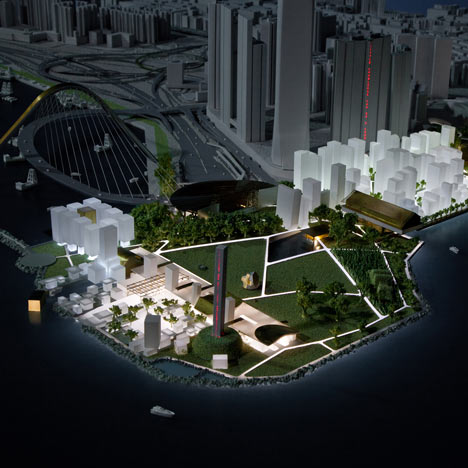
West Kowloon Cultural District by OMA
Rotterdam architects OMA have announced their proposed masterplan for a new cultural district in Hong Kong.
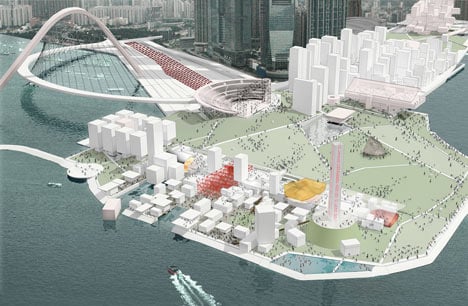
The 40 hectare site would comprise three 'urban villages' situated within a park connected to the existing Kowloon Park, forming the largest public green space in Hong Kong.
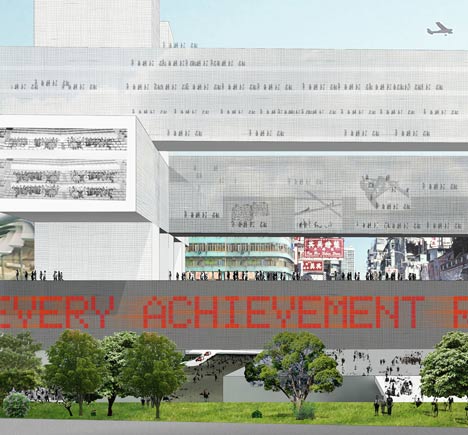
One of three contenders for the site, the scheme consists of a museum and exhibition space, performance venues, a market and an open-air amphitheatre seating 15,000.

Explore the proposal in detail on the West Kowloon Cultural District Authority website.
Read our stories about the competing proposals by Foster + Partners here and by Rocco Design Architects here.
Here's more from OMA:
OMA reveals plans for new cultural district in Hong Kong
Hong Kong, 20 August 2010 – The West Kowloon Cultural District Authority unveiled today OMA’s conceptual masterplan for a major new arts district in Hong Kong. Under OMA’s plan – one of three competing proposals – the 40 hectare waterfront site facing Victoria Harbour would become an authentic environment of three urban villages embedded in a new public park, Hong Kong’s largest.
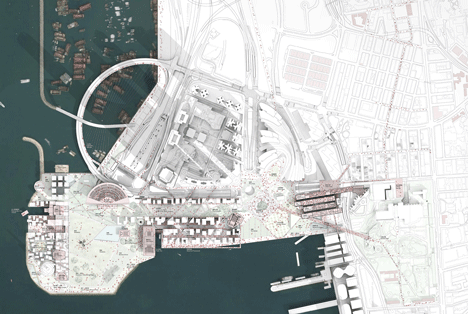
Click above for larger image
OMA founding partner Rem Koolhaas commented: “Using the village – a typology every citizen of Hong Kong is familiar with – as the model for our plan allows us to absorb the massive scale of WKCD’s ambition into manageable portions and forge deep connections with Kowloon, whose vital urban energy will be the lifeblood of WKCD.”
In 2009, OMA established a new office in Hong Kong to study local conditions and consult with a wide range of stakeholders and experts in the fields of culture and finance. Out of this research, we generated a cultural masterplan, working in tandem with architecture, for establishing a creative milieu that can fully ‘inhabit’ WKCD’s plethora of new arts facilities and make the neighbourhood come alive.
OMA’s three villages each have a strong emphasis on vibrant street life and cultural production where all aspects of the creative process – from education to rehearsal to production to performance – are nurtured and made visible.
Art in the east
One of the key elements of OMA’s proposal for WKCD is M+, an experimental new museum interpreted as a barcode of overlapping bands featuring visual art, film, design and popular culture. Embedded in M+ is an Art Factory, where education, artist studios, a hotel and shops intersect and interact with the museum itself. Beneath M+, the Exhibition Centre is a venue for auctions and conventions, a further intermingling of culture and commerce. M+ links to Kowloon Park and to the surrounding neighbourhood with pedestrian bridges – one of them an
extension of the park, one an extension of the museum itself – into Jordan and to Temple Street, and across Canton Road to an outpost of the museum in Victoria Towers.
Market in the middle
The Middle Village is conceived as a continuation of Kowloon’s street markets, with small-scale entertainment, local shops, restaurants, street markets, artist studios, production spaces, and galleries. The Middle Village is flanked by a Xiqu Theatre (and a Xiqu School) for Cantonese performance and, to the east, a premiere movie theatre celebrating Hong Kong’s film industry.
Performance in the west
With views over the water and Victoria Harbour, the focal point of Theatre Village is the Uni- versal Theatre, a network of four interconnected performance spaces: chamber music theatre, street theatre, grand theatre and a concert hall. Each venue is embedded in a single, continu- ous outdoor lobby stretching the length of the village. Below the lobby, the public can tour the shared rehearsal, production and technical spaces for all four theatres.
The Mega Performance Venue
Located in parkland between the West and Middle Villages, the Mega Performance Venue is an open-air amphitheatre based on the ancient Greek and Roman model. It seats 15,000 people for large scale entertainment ranging from pop concerts to New Year’s celebrations with views over Hong Kong Island as its natural backdrop.
Park of the New Horizon
All three villages are embedded in a single park, which connects with Kowloon Park via a planted green bridge to form the largest public green space in Hong Kong. WKCD’s Park of the New Horizon offers a space liberated from the commercial, and also from the wealth of interdic- tions familiar in most of Hong Kong’s open space. We draw from tropical agriculture and the fishponds of the Mai Po wetlands not only as a repertoire of species and cultivation methods, but as a mechanism for organizing communal action. Forest gardens, orchards, ponds, mead- ows, and even communal urban farming are all connected by paths for pedestrians and cyclists.
OMA’s conceptual plan will be discussed in a series of public forums in the coming three months, in which OMA is represented by Rem Koolhaas, David Gianotten and Betty Ng. The project is also on display in roving exhibitions across Hong Kong from 20 August until 20 November and at the 12th International Architecture Exhibition in Venice from 29 August until 21 November.
DezeenTV:
Click on the symbol in the bottom right of the video player above to view the movie in full-screen HD.
Can’t see the movie? Click here.
See also:
.
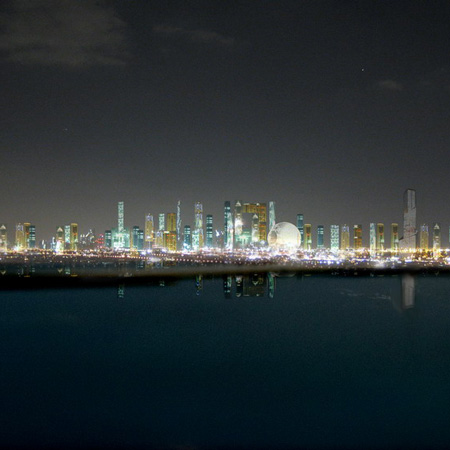 |
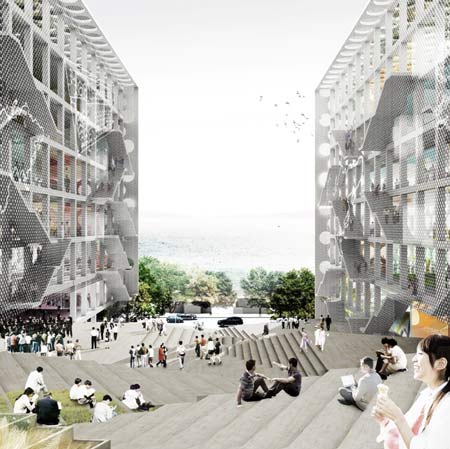 |
 |
| Waterfront City masterplan by OMA |
Chu Hai College Campus by OMA |
All our stories about OMA |